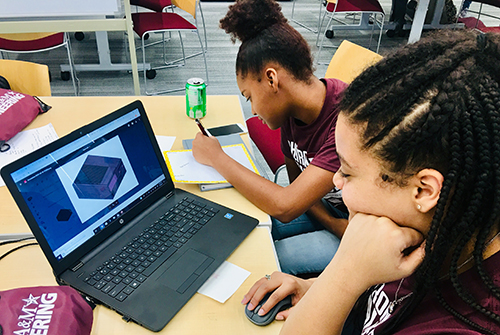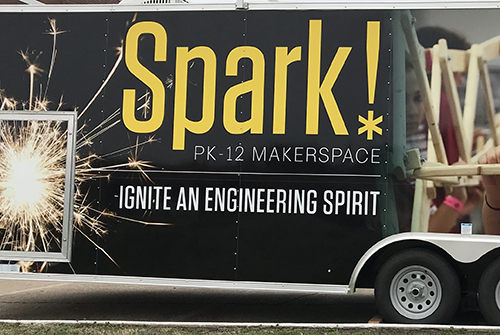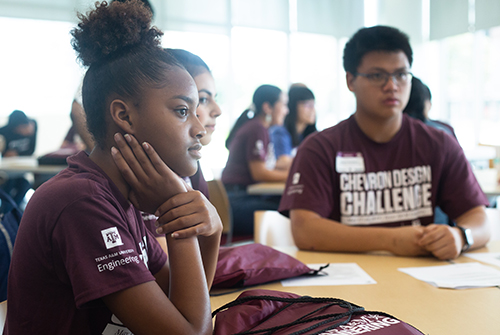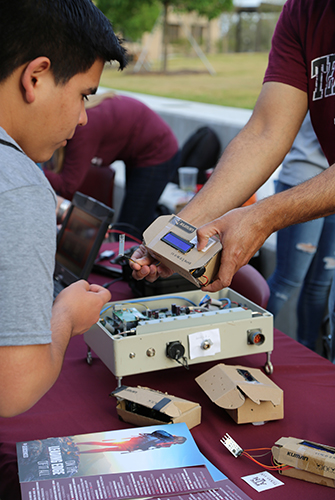 Spark! PK-12 is an outreach program in the College of Engineering designed to create a pipeline of future engineering talent. In collaboration with Texas school districts, Spark! seeks to improve student access and enhance instruction in STEM subjects.
Spark! PK-12 is an outreach program in the College of Engineering designed to create a pipeline of future engineering talent. In collaboration with Texas school districts, Spark! seeks to improve student access and enhance instruction in STEM subjects.
Future demand for engineers is projected to grow nationally through 2024, according to the U.S. Bureau of Labor Statistics. Texas A&M University’s College of Engineering is committed to doing its part to fill this need and is taking its leadership one step further through the Spark! PK-12 Engineering Education Outreach effort.
The brainchild of Dr. M. Katherine Banks, vice chancellor and dean of engineering, this outreach program creates a pipeline of future engineering talent. Through Spark!, College of Engineering faculty and staff collaborate with Texas school districts to improve student access and enhance instruction in science, technology, engineering and math (STEM) subjects.
Yet this innovative and timely program faces daunting financial challenges. Spark! receives its primary funding from the Texas Engineering Experiment Station and the college’s Engineering Academic and Student Affairs office. However, the Texas A&M engineering budget allocations vary from year to year and declining K-12 school district budgets hamper some schools’ abilities to pay for professional development and outreach programs. “We want to reach the far corners of the state and bring Texas A&M engineering on the road, especially to those students with limited exposure to engineering as a profession, but we need more resources to do so,” said Spark! PK-12 Outreach Director Shelly Tornquist.
Generous gifts to Spark! through the Texas A&M Foundation can make a significant difference in developing the skills of the state’s and nation’s next generation of engineers. Individuals can support PK-12 students’ participation in different events, create teacher fellowships or scholarships, name specific Spark! programs or create a director’s discretionary excellence fund.
 The Spark! Mobile Maker Space is a 26-foot trailer that brings Texas A&M Engineering to schools across Texas.
The Spark! Mobile Maker Space is a 26-foot trailer that brings Texas A&M Engineering to schools across Texas.
Enhancing STEM Engagement
Spark! creates robust experiential educational opportunities for students in prekindergarten through 12th grade, their teachers and their families through programs hosted at Texas A&M as well as at the regional and local levels.
“We want parents to know what engineering is and how they can encourage their children to take high-level math and science courses, so students are ready when they get to college,” Tornquist said. “The only way to do that is to work with families so they know how to encourage their children and then work with teachers, particularly K-8 teachers. We know that kids really start losing interest in math and science about third and fourth grade. But if they do some of our engineering projects, they become excited about the practical side of what math and science can do to solve a problem.”
Since 2016, the Spark! outreach effort has engaged more than 86,000 students, teachers, families and other stakeholders through a variety of ways, including STEM festivals, campus visits and activities, local engineering clubs and career fairs, College of Engineering campus events and tours, and conferences and workshops for educators. Spark! staff also coordinate a weekly engineering club at College Station’s Lincoln Center, an after-school youth center, and are involved with the George H.W. Bush Presidential Library and Bryan ISD’s new manufacturing center.
Going Mobile
Bringing a school’s entire teaching staff to Texas A&M would be cost-prohibitive and disrupt critical instructional time. That’s where the Spark! Mobile Maker Space comes in. The 26-foot enclosed trailer can easily be transported to bring Texas A&M’s engineering expertise to PK-12 campuses across the state.
Once on-site, Spark! staff members use the trailer’s contents to engage school teachers in creating rich STEM experiences for students by using the Mobile Maker’s equipment, which includes 3D printing, a mill, a lathe and welding equipment. “Teachers need to know how to do engineering, not just in theory, but also how to practice it with the maker space,” said Tornquist, who previously spent 26 years as a high school engineering design and manufacturing teacher.
 The Chevron Design Challenge, also coordinated by Spark!, is a two-day competition in which Texas high school freshmen, sophomores and juniors use engineering concepts to address society's most pressing issues. The competition requires participants to work in teams and create mock-ups of their solutions.
The Chevron Design Challenge, also coordinated by Spark!, is a two-day competition in which Texas high school freshmen, sophomores and juniors use engineering concepts to address society's most pressing issues. The competition requires participants to work in teams and create mock-ups of their solutions.
The trailer lets Spark! staff tailor professional development offerings to the campus’s specific needs. For example, Spark! Associate Director John Peterson, a former high school engineering teacher, had the opportunity to bring the Mobile Maker Space to Wilemon STEAM Academy in Waxahachie ISD. “This particular school was opening as a STEAM academy,” Peterson said. “They knew where they wanted to end the school year, but they were seeking guidance on where to start. We helped them take off instructionally during the first two weeks of school and showed them ways they could implement engineering education down the road.”
The Spark! staff’s support was instrumental in Wilemon Academy becoming only the third school in the nation to receive the National Certificate for STEM Excellence by the National Institute of STEM Education. To achieve this, 29 campus employees—including all classroom teachers, administrators and the librarian—each participated in approximately 100 hours of professional development and successfully completed an individual certification process, while meeting all goals within their STEM action plan.
Hosting Texas Students
Spark! also coordinates the Chevron Design Challenge, which gives Texas high school freshmen, sophomores and juniors the opportunity to use engineering concepts to address some of society’s pressing problems, such as sudden infant death syndrome (SIDS), helping elders with medications and assisting individuals with poor eyesight.
The two-day intensive competition, held in May, required participants to work in a team with counterparts from different schools to brainstorm and create a mock-up of their engineering solution. Students received regular feedback from mentors made up of retired engineers, Texas A&M faculty and graduate students, and U.S. Army representatives. In addition, teams presented their design to a panel of judges made up of Chevron representatives and Texas A&M faculty.
The winning team devised a mechanical bed that would reposition a sleeping infant who was in danger of SIDS. However, all of the participants felt like winners. “It was great just being able to connect and work with different people from all around the state and actually gain a viewpoint as to what engineering really is,” one student said.
 Another event held by Spark! is the Texas Science and Engineering Fair. Held at the Ford Hall of Champions at Kyle Field, students can submit a science and engineering project to be judged as well as attend an outreach event where they can experience the many STEM departments at Texas A&M.
Another event held by Spark! is the Texas Science and Engineering Fair. Held at the Ford Hall of Champions at Kyle Field, students can submit a science and engineering project to be judged as well as attend an outreach event where they can experience the many STEM departments at Texas A&M.
Furthermore, Spark! also hosts the Texas Science and Engineering Fair, which brings nearly 1,300 students in grades six to 12 to Aggieland each spring. “These kids come from all over Texas,” Tornquist said, “and many of them have never been to Texas A&M before.”
The event, held at the Ford Hall of Champions at Kyle Field in March, provided an opportunity for students to submit a science and engineering project to be judged. In addition, the fair includes an outreach event, Night at the Zach, which includes a DJ, food, student performances and hands-on activities at the new Zachry Engineering Education Complex led by various Texas A&M colleges that are involved in STEM education. “We were there to welcome the students with Aggie hospitality, have fun, show them the university and host an engaging hands-on event for students,” Peterson said. “Wildlife and Fisheries Sciences brought animals, Chemistry was making slime, and all of the engineering departments had immersion experiences available for the students, from robots to virtual reality.”
Growing Exponentially
Although Spark! offers a number of well-regarded programs, the Spark! staff remain committed to devising new and innovative ways to engage PK-12 students and help school teachers feel comfortable with STEM concepts. For example, they plan to provide teachers with a step-by-step template on how to hold a STEM Expo or STEM Family Night at their schools. “We’re trying to find ways to sustain our work after we visit a school,” Peterson said. “Even though it’s a big, scary new world for teachers, we want to knock those STEM butterflies out and give them all the tools they need to conquer a STEM curriculum.”
To learn how you can support the Spark! PK-12 Engineering Education Outreach program, contact Reagan Chessher ’96, senior director of development, below at (979) 458-8654 or rchessher@txamfoundation.com.